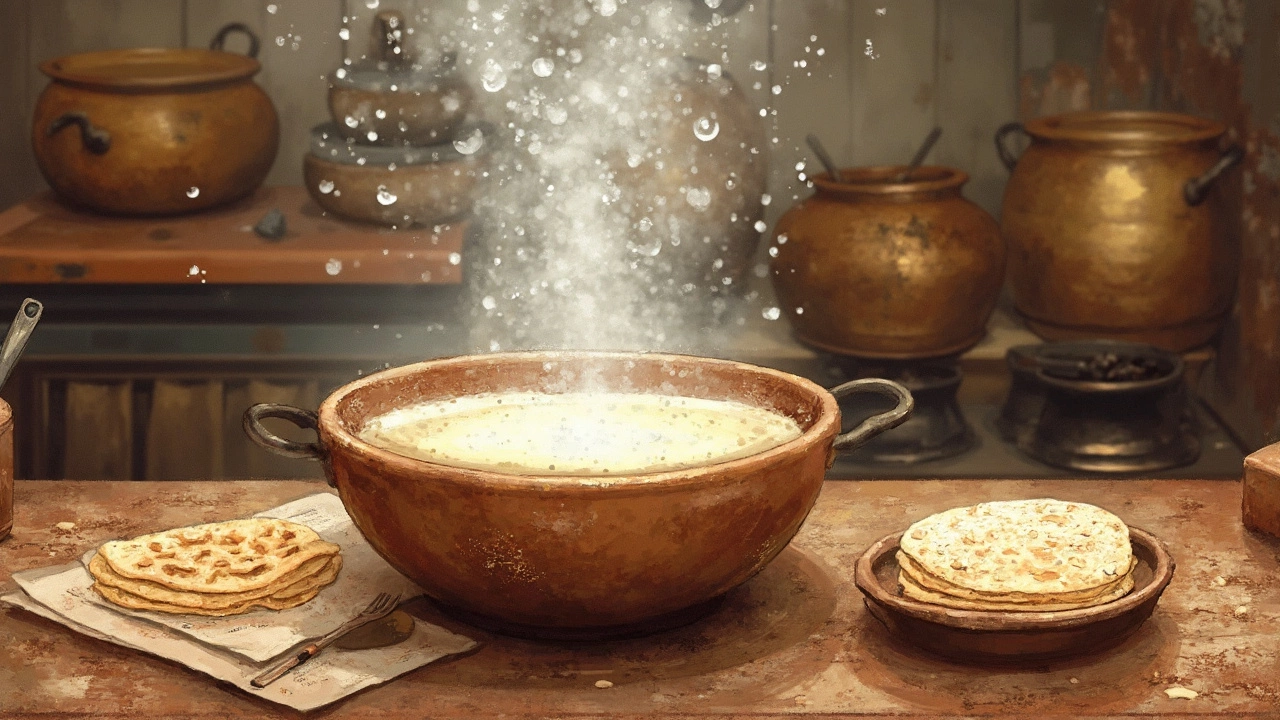Lying in bed last Sunday, my dog Luna staring at me, I remembered I had promised dosa for brunch. Hungry faces waiting, two hours on the clock, and a lump of just-ground batter in the bowl—can it really ferment that fast? If you’ve ever found yourself in a pinch, wondering if you can whip up dosa with barely any wait, you’re not alone.
Here’s the thing: classic dosa batter needs time. The lentils and rice don't just combine and magically rise—bacteria get to work, eating up sugars and getting that lovely tang and airy texture. Traditionally, you’re looking at 8 to 12 hours of patience, sometimes overnight, depending on the weather.
But kitchen emergencies demand hacks, right? If you’re aiming for dosa on the double, you need to know what's possible and what’s just wishful thinking. There are tricks, like using warm water, adding a pinch of sugar, or sneaking in some yogurt. Each hack changes not just the speed of fermentation, but also the taste and texture.
- What Actually Happens During Fermentation
- Is 2-Hour Fermentation Possible?
- Speed Up Fermentation—Tricks That Work
- What to Expect from 2-Hour Dosa Batter
What Actually Happens During Fermentation
Okay, so what’s going on with dosa batter when it just sits there? It’s not just sitting—it’s busier than it looks. Fermentation is when good bacteria and wild yeast start working on the soaked rice and urad dal (split black gram). This friendly army eats the natural sugars and starches, breaking them down and making stuff like carbon dioxide, acids, and ethanol. Those bubbles you see? That’s CO2 lifting the batter and making dosas light and airy.
Temperature plays a huge role. For classic dosa, the sweet spot is between 28℃ and 32℃ (82℉–90℉). Too cold and it drags on forever; too hot and things can taste off. Even the tiniest temperature changes can mean hours more or less fermenting time. And yes, humidity helps.
If you want to see what you’re really improving here, check this out:
| Stage | Batter pH | Common Texture |
|---|---|---|
| Before fermentation | ~6.5 | Dense, gritty |
| After 8 hours | 5.5–6 | Getting airy, slightly tangy |
| After 12 hours | 4.5–5.5 | Light, fluffy, distinctly tangy |
You might be surprised to hear that in one study, fully fermented dosa batter had over 50 million lactic acid bacteria in every gram—that’s a lot of mini workers giving your dosa better flavor and texture.
According to Dr. V. Prakash, former director of the Central Food Technological Research Institute,
“Natural fermentation develops the flavor, texture, and nutritional profile of dosa. Speeding it up changes not just the time but the entire process.”
So that rise, the tang, and even the golden crisp you want on your dosa? It’s all thanks to what’s happening in the batter bowl while you wait. If the process is rushed, your batter ends up missing these key improvements. That’s why understanding dosa batter fermentation is so important, especially if you're considering the 2-hour shortcut.
Is 2-Hour Fermentation Possible?
If you’re chasing dosa batter that’s fully fermented in just 2 hours, let’s cut to the chase: it’s not the norm. Dosa batter typically takes at least 8 hours to ferment at room temp, sometimes longer in cooler climates. South Indian grandmas will tell you, fermentation is all about patience, temperature, and nature’s invisible helpers—wild lactobacillus bacteria.
But what about doing it faster? You can try, but true fermentation just can’t be rushed much. The classic tang and airy rise in batter comes from a slow build-up of beneficial microbes breaking down starch. In 2 hours, you might see a few bubbles if you’re lucky, but usually, the batter just sits there looking the same as when you started.
Still, there are ways to cheat a bit if you’re desperate for a quick fix. Folks sometimes add commercial yeast, baking soda, or yogurt to help things along, but the taste and texture change. It won't be the iconic dosa bite, but you'll get something you can eat with chutney. Here’s how temperatures play into it:
| Room Temperature | Average Fermentation Time |
|---|---|
| 30-32°C (86-90°F) | 8-10 hours |
| 20-25°C (68-77°F) | 12-18 hours |
| In oven with light on (approx. 35°C/95°F) | 6-8 hours |
| Attempted 2-hour fermentation | Mostly incomplete; quick hacks may work |
A true dosa batter needs more time for those complex flavors. If you skip to a 2-hour shortcut using instant methods, expect less sourness and a texture that’s a little more pancake than dosa. It’s almost like using training wheels—the batter holds together, but the real experience takes longer. If you’re really pressed, it can still be breakfast... just with a disclaimer!

Speed Up Fermentation—Tricks That Work
If you’re staring at your unfermented batter and the clock’s ticking, there are a few real ways to get things moving. First off, if it’s winter or you’ve cranked up the air conditioning, know that a chilly kitchen is your enemy. The friendly bacteria need warmth.
- Warmth Is Key: Place your vessel of batter in the warmest spot possible. Near your oven’s pilot light, on top of the fridge, or even inside your oven with just the oven light on (not heated!). Aim for around 30°C (86°F).
- Add a Pinch of Sugar: Sugar doesn’t change the taste much in small amounts but does give the wild yeast and lactobacilli a quick energy boost, helping them multiply quicker.
- Mix in Yogurt: A spoonful of plain yogurt (with active cultures) borrowed from your fridge can add those helpful bacteria. This is especially useful if you’re somewhere cold.
- Batter Consistency: A thick batter slows down fermentation. Make sure your *dosa batter* is at a pourable, pancake-like consistency—thicker than milk but thinner than cake batter. More surface area and moisture help things along.
- Grind Hot: If you grind the soaked rice and dal using warm (not hot!) water, the extra heat gives early fermentation a push. Just don’t overheat, or you’ll kill the natural microbes.
Some folks also use a pinch of dry yeast. A quarter teaspoon per cup of batter usually does the job. Your dosas will bubble up, but you’ll notice a slightly bread-like taste instead of the traditional tang.
| Trick | Time Saved | Impact on Flavor |
|---|---|---|
| Warm place (30°C/86°F) | 2-3 hours | Good, close to traditional |
| Add sugar | 1-2 hours | No major effect |
| Add yogurt | 1-2 hours | Slightly tangy, soft crisp |
| Add dry yeast | 4-6 hours less | More bread-like |
Just remember, even with these tricks, flavor and texture won’t quite match overnight fermentation. But if you’re short on time and big on cravings, these hacks are your best bet.
What to Expect from 2-Hour Dosa Batter
If you try to make dosa with batter that’s only had two hours to ferment, here’s what’s really going down. The batter won’t have the classic tang you get with good, old-fashioned slow fermentation. The flavor will be more plain—almost flat compared to the usual slightly sour punch. The texture is where you’ll see a bigger difference. Don’t wait for those big bubbles; two hours isn’t really enough for wild fermentation magic to happen. You might notice a few tiny bubbles if it’s super warm, but most of the time, it’s just thicker and heavier than the fully-risen stuff.
When you pour it on the pan, the dosa batter will spread, but the finished dosa will likely be a bit denser and softer. You won’t get those crunchy edges that most people crave. Instead, expect more of a soft crepe style, kind of like uttapam but thinner. If you’ve ever bought instant dosa mixes and felt a bit let down, that’s pretty much what you’re getting here.
Your dosas will still be totally edible, especially with chutney and sambar, but they probably won’t wow anyone who grew up eating the real deal. If you want to boost the odds of a better rise, you could add some yogurt or a pinch of baking soda. But just remember: there’s no shortcut for that deep, developed flavor and classic crispiness that slow fermentation brings. Two-hour dosa batter will save time, but you trade off some taste and texture for convenience.
